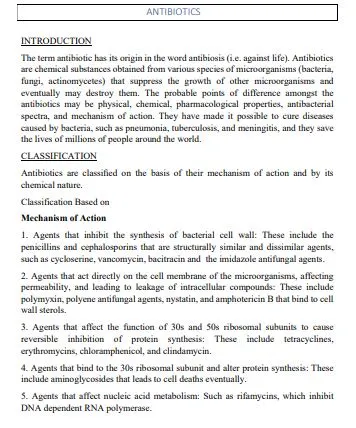‘Antibiotic Classification’ PDF Quick download link is given at the bottom of this article. You can see the PDF demo, size of the PDF, page numbers, and direct download Free PDF of ‘Antibiotic Classification’ using the download button.
Classification Of Antibiotics With Examples PDF Free Download

Classification of antibiotics with examples PDF
INTRODUCTION
The term antibiotic has its origin in the word antibiosis (i.e. against life). Antibiotics are chemical substances obtained from various species of microorganisms (bacteria, fungi, actinomycetes) that suppress the growth of other microorganisms and eventually may destroy them.
The probable points of difference amongst the antibiotics may be physical, chemical, pharmacological properties, antibacterial spectra, and mechanism of action.
They have made it possible to cure diseases caused by bacteria, such as pneumonia, tuberculosis, and meningitis, and they save the lives of millions of people around the world.
CLASSIFICATION
Antibiotics are classified on the basis of their mechanism of action and by its chemical nature. Classification Based on Mechanism of Action
1. Agents that inhibit the synthesis of bacterial cell wall: These include the penicillins and cephalosporins that are structurally similar and dissimilar agents, such as cycloserine, vancomycin, bacitracin and the imidazole antifungal agents.
2. Agents that act directly on the cell membrane of the microorganisms, affecting permeability, and leading to leakage of intracellular compounds: These include polymyxin, polyene antifungal agents, nystatin, and amphotericin B that bind to cell wall sterols.
3. Agents that affect the function of 30s and 50s ribosomal subunits to cause reversible inhibition of protein synthesis: These include tetracyclines, erythromycins, chloramphenicol, and clindamycin.
4. Agents that bind to the 30s ribosomal subunit and alter protein synthesis: These include aminoglycosides that leads to cell deaths eventually.
5. Agents that affect nucleic acid metabolism: Such as rifamycins, which inhibit DNA dependent RNA polymerase.
Classification Based on Chemical Structure
1. β-lactam antibiotics
2. Aminoglycoside antibiotics
3. Tetracycline antibiotics
4. Polypeptide antibiotics
5. Macrolide antibiotics
6. Lincomycins
7. Other antibiotics
1. β-lactam antibiotics These consists of two major class of agents, that is penicillins and cephalosporins.
a. Penicillins:
Penicillin, the most important antibiotic, was first extracted from the mould Penicillium notatum.
Subsequently, a mutant of a related mould, P. chrysogenum, was found to give the highest yield of penicillin and is employed for the commercial production of this antibiotic.
Penicillin belongs to a group of antibiotics called βlactam antibiotics .
The basic structure of the penicillins consists of a thiazolidine ring fused with a β-lactam ring, which is essential for antibacterial activity.
These two rings constitute the fundamental nucleus of all the penicillins, namely, 6-amino penicillanic-acid (6-APA) A variety of semisynthetic penicillins are produced by altering the composition of the side chain attached to 6-APA nucleus.
Both the 6- APA nucleus and side chain are essential for the antibacterial activity.
Nomenclature Penicillins are named in the following ways: a. Chemical abstract 1.
The penicillins are described as 4-thia-1-azabicyclo (3.2.0) heptanes. 2. Benzylpenicillin is 6-(2-phenylacetamido)-3, 3-dimethyl-7-oxo-4-thia-1- azabiclo(3.2.0)heptane2-carboxylic acid. b. Penam: In order to simplify the unsubstituted bicylic ring system of penicillin, it is given the name penam.
Accordingly, the penicillins are 6-acylamino-2, 2-dimethyl penam-3-carboxylates.
CEPHALOSPORINS
The cephalosporins were isolated from the fungus Cephalosporium acremonium in 1948 by Pro Tzu, Newton, and Abraham (1953).
The main product being cephalosporin-C, the molecular modifi cation of cephalosporin-C gave origin to semisynthetic substances.
They are β-lactam antibiotics with same fundamental structural requirements as penicillins, the main difference between the two is that cephalosporins contain dihydrometathiazine ring, while penicillin contains a tetrahydrothiazole (thiazolidine) ring.
The cephalosporins are much more acid stable than the corresponding penicillins and also have a mechanism of action similar to that of penicillins; they mainly inhibit the cross-linking of the peptidoglycan units in bacterial cell walls by inhibiting transpeptidase enzyme.
However, they bind in the target proteins other than penicillins binding proteins. Cephalosporins can be divided into three classes:
1. Cephalosporin N: It has a penicillin-like structure being a derivative of 6- aminopenicillanic acid.
2. Cephalosporin P: An acidic antibiotic, which is steroidal in nature.
3. Cephalosporin-C: It is a true cephalosporin and it is a derivative of 7 aminocephalosporanic acid.
Nomenclatures
Cephalosporins are named in the following ways: 1. Chemical abstracts: 5-Thia-1-azobicyclo (4.2.0) octanes. Accordingly, cephalothin is 3-(Acetoxy methyl)-8-oxo-7-(2-thienyl) acetamido-5thia-1-azabicyclo[4.2.0]-oct-2ene-2-carboxylic acid. 2. Cepham derivatives: Cepham is the name given to the unsubstituted bicyclic lactam.
2. AMINOGLYCOSIDE
ANTIBIOTICS The aminoglycoside antibiotics contain one or more amino sugars linked to an aminocytitol ring by glycosidic bonds.
These are broad-spectrum antibiotics; in general, they have greater activity against gram-negative than gram-positive bacteria.
The development of streptomycin, the fi rst antibiotic of this group, was a well-planned work of Waksman (1944) and his associates, who isolated it from a strain of Streptomyces griseus.
The aminoglycoside can produces severe adverse effects, which include nephrotoxity, ototoxicity, and neuro effects.
These properties have limited the use of aminoglycoside chemotherapy to serious systemic indications. Some aminoglycosides can be administered for ophthalmic and topical purposes.
Mode of action:
The aminoglycosides exhibit bactericidal effects as a result of several phenomena.
Ribosomal binding on 30s and 50s subunits as well as the interface produces misreading; this disturbs the normal protein synthesis. Cell membrane damage also plays an integral part in ensuring bacterial cell death.
SAR of Aminoglycoside Antibiotics
The aminoglycosides consist of two or more amino sugars joined in glycoside linkage to a highly substituted 1,3-diaminocyclo hexane (aminocyclitol), which is a centrally placed ring. The ring is a 2-deoxy streptamine in all aminoglycosides except streptomycin and dihydrostreptomycin, where it is streptidine. Thus,
• In kanamycin and gentamycin families, two amino sugars are attached to 2-deoxy streptamine.
• In streptomycin, two amino sugars are attached to strepidine.
| Language | English |
| No. of Pages | 41 |
| PDF Size | 1 MB |
| Category | Health |
| Source/Credits | annamalaiuniversity.ac.in |
Classification Of Antibiotics With Examples PDF Free Download
